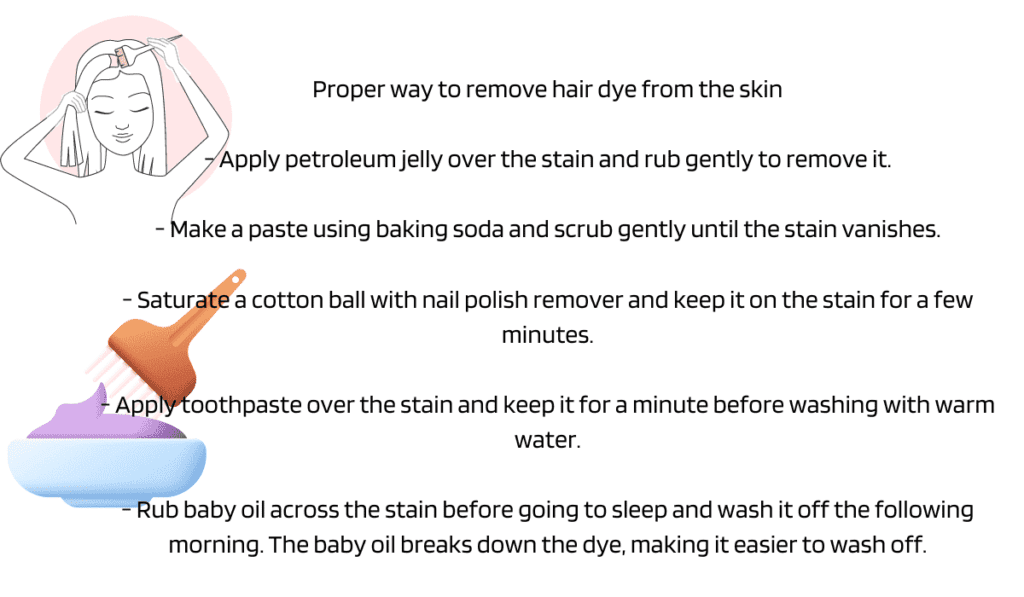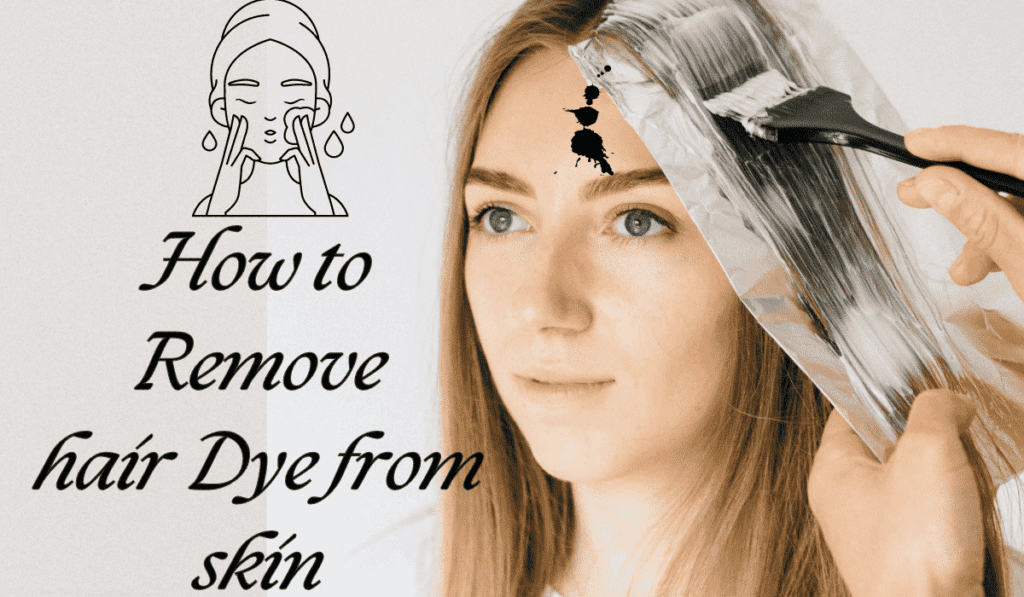“Many people choose to dye their hair at home because of its affordability, convenience, and privacy.”
However, there are times when dye accidentally stains the skin, forehead, neck, hairline, and hands, even nails.
But worry not, for we have a complete solution for you.”
Use warm water with soap but sometimes stain remover products can damage your skin cells.
Remove hair dye from the skin, hairline and face

Removing hair dye stains from the skin, particularly around delicate areas like the hairline and face, requires trusted methods to ensure effectiveness and safety. Here are scientifically supported techniques:
Makeup Remover
Dermatologists widely recommend using a gentle makeup remover or micellar water to efficiently lift hair dye stains from the skin [1]. These products are formulated with ingredients known for effectively cleansing the skin without irritating it. Cosmetic Dermatology Principles and Practice by Leslie Baumann, MD.
Baby Oil or Coconut Oil
Trusted by professionals, baby oil or coconut oil is often suggested for breaking down hair dye stains on the skin. These oils are renowned for their mild properties, ensuring they effectively dissolve the dye without causing harm. Moreover, dermatologists often endorse these oils for their moisturizing benefits, which can aid the skin during stain removal.
Recommended as a preventive measure by many experts, petroleum jelly forms a protective barrier between the dye and the skin. Its effectiveness in preventing stains is well-established, and when stains occur, applying petroleum jelly to the affected areas can gently lift the dye without further irritation.
Baking Soda Paste
Recognized for its exfoliating properties, baking soda is often cited as a reliable solution for removing hair dye stains. Its mild abrasive nature allows for gentle exfoliation, effectively lifting the dye from the skin without causing harm. However, caution is advised, especially for individuals with sensitive skin.
Lemon Juice
While lemon juice is a natural remedy for stain removal, dermatologists caution against its use due to its acidic nature, which can potentially irritate sensitive skin. Nevertheless, many experts recommend it for its ability to fade hair dye stains effectively. Before application, a patch test is advisable to ensure compatibility with the skin.
Apply Toothpaste
Gently rub a small amount of toothpaste onto the stained area of the skin. Toothpaste contains mild abrasives that can help lift the dye stain.
Removing dye from hands
Removing dye from the hands can be done using similar methods to those for removing dye from the hairline and face. Here are some trustworthy techniques:
Soap and Water
Start by washing your hands with warm water and a gentle soap. Rub your hands together to create a lather and focus on the areas with dye stains. Rinse thoroughly with warm water, also 2 -4 times wash your face with water daily to give you excellent results in your skin routine.
Baking Soda Paste
Create a paste using baking soda and water. Gently massage the paste onto the stained areas of your hands. Baking soda’s mild abrasive properties can help lift the dye stains. Rinse your hands thoroughly with warm water.
Lemon Juice
Lemon juice can also help remove dye stains from hands due to its acidic nature. Squeeze fresh lemon juice onto the stained areas and rub it gently into the skin. Let it sit for a few minutes, then rinse off with warm water.
Hand Sanitizer
Hand sanitizers containing alcohol can effectively break down dye stains. Apply a small amount of hand sanitizer to your hands and rub it into the stained areas. Continue rubbing until the dye starts to lift off. Then, wash your hands with soap and water.
Rubbing Alcohol
If the dye stains are stubborn, you can try using rubbing alcohol. Dampen a cotton ball or pad with rubbing alcohol and gently dab it onto the stained areas. Rubbing alcohol helps dissolve the dye, making it easier to remove. Afterward, wash your hands with soap and water.
How to prevent hair dye stains
Preventing hair dye stains on the skin is often easier than removing them afterward. Here are some reliable methods to help avoid staining:
Apply a Protective Barrier
Before dyeing your hair, apply a thin layer of petroleum jelly or a barrier cream around your hairline, ears, and neck. This creates a protective barrier that helps prevent the dye from coming into contact with your skin.
Use a Stain Guard
Some hair dye kits come with a stain guard or barrier cream specifically designed to prevent skin staining. Follow the instructions provided in the kit to apply the product effectively.
Wear Protective Clothing
Wear old clothing or use a hairdressing cape to protect your skin from dye splatters. Additionally, consider using disposable gloves to prevent dye from staining your hands.
Section Your Hair Carefully
Divide your hair into sections before applying the dye to ensure even coverage. This can help minimize the risk of accidentally getting dye on your skin.
Be Mindful During the Application
Take your time and apply the dye carefully, avoiding contact with your skin as much as possible. Use a small brush or applicator to apply the dye precisely to your hair.
Clean Up Spills Immediately
If you do accidentally get dye on your skin, wipe it off immediately with a damp cloth or cotton pad. The longer the dye sits on your skin, the more likely it is to stain.
Follow Instructions
Always follow the instructions provided with the hair dye kit carefully. This includes performing a patch test before dyeing your hair to check for any allergic reactions and following the recommended application techniques.
The takeaway
Next time before doing the dye process remember these proven methods for preventing hair dye stains on the skin are clear: by incorporating protective measures such as applying a barrier cream, wearing protective clothing and gloves, and being mindful during application, individuals can significantly reduce the risk of staining. These recommendations are supported by reputable sources in dermatology and cosmetic science.
How to strip Unwanted hair dye effectively
according to the research 75% percent of women and 38% of men color their hair regularly—about every six to eight weeks.
Stripping unwanted hair color can be tricky, but it can be done safely with the right techniques. Before attempting to strip your hair color at home, it’s essential to understand how hair dye works and what methods are available for removing it. Here’s a breakdown:
How Hair Dye Works
Hair dye contains chemicals that penetrate the hair shaft to alter its color. Permanent hair dye typically uses ammonia and peroxide to lift the natural hair color and deposit the new color molecules.
Semi-permanent and temporary dyes contain smaller molecules that coat the outer layer of the hair shaft without penetrating deeply.
Stripping Hair Color at Home:
- Clarifying Shampoo: Start by using a clarifying shampoo to remove as much pigment buildup as possible.
- Baking Soda Paste: Create a paste with baking soda and water, apply it to your hair, and let it sit for about 10-15 minutes before rinsing. This can help to lighten the color.
- Vitamin C Treatment: Crush vitamin C tablets and mix them with clarifying shampoo. Apply this mixture to your hair and leave it for about an hour before rinsing. Vitamin C is mildly acidic and can help fade hair color.
- Color Remover: There are color-removing products available in stores that can help strip unwanted dye from your hair. Follow the instructions carefully.
What to Avoid:
- Bleach: Avoid using bleach at home as it can severely damage your hair if not applied correctly.
- Excessive Heat Styling: Heat styling tools can further damage your hair, so avoid using them excessively, especially when trying to remove hair color.
- Overwashing: While you may be tempted to wash your hair frequently to remove color, overwashing can strip your hair of natural oils and exacerbate dryness.
Professional Treatment Summary:
If you’re unsure about stripping your hair color at home or if the color is too stubborn, it’s best to seek professional help. A professional colorist can assess your hair’s condition and choose the safest and most effective method for removing the unwanted color. They may use techniques such as color correction, which involves applying a new color to neutralize or cover the unwanted shade.
Remember, stripping hair color can be harsh on your hair, so it’s essential to follow up with deep conditioning treatments to restore moisture and maintain the health of your hair.
How to remove henna and permanent hair dye from the skin
To remove both henna and permanent hair dye from the skin, you can try the following methods:
Immediate cleaning: If the henna or hair dye is still wet on the skin, immediately wipe it off with a damp cloth or cotton pad. Avoid rubbing too hard to prevent spreading the dye.
Soap and water: Wash the stained area thoroughly with soap and warm water. Use gentle circular motions to help lift the dye from the skin. You may need to repeat this process several times, especially if the dye has already dried.
Exfoliation: Use an exfoliating scrub to help remove the outer layers of skin where the dye pigment resides. You can use a commercial scrub or make one at home using ingredients like sugar, honey, and lemon juice. Gently scrub the stained area and rinse with warm water.
Oil-based removers: Apply a gentle oil, such as olive oil, coconut oil, or baby oil, to the stained skin. Let it sit for a few minutes to help break down the dye pigment. Then, gently massage the area and rinse with warm water.
Makeup remover or cleansing oil: Apply a makeup remover or cleansing oil to the stained skin and gently massage it in. These products can help dissolve the dye and lift it from the skin. Rinse the area with warm water afterward.
Baking soda paste: Mix baking soda with a small amount of water to create a paste. Apply the paste to the stained skin and gently scrub in circular motions. Rinse off with warm water.
Rubbing alcohol or nail polish remover: Use rubbing alcohol or non-acetone nail polish remover on a cotton ball to dab at the stained skin. Be cautious with this method as it can be drying and may cause irritation for some individuals. Rinse the area with warm water afterward.
